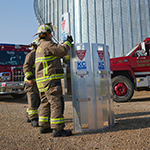Anhydrous ammonia safety
Reduce your risk of exposure and severe injury by following these important guidelines.
Anhydrous ammonia is an efficient and widely used source of nitrogen fertilizer. Anhydrous ammonia has several advantages, including its relatively easy application and ready availability. However, its chemical properties make it extremely dangerous.
Generally, the severity of symptoms depends on the degree of exposure. Symptoms include burning of the eyes, nose and throat after breathing even small amounts. With higher doses, coughing or choking may occur. Eye exposure to concentrated gas or liquid can cause serious corneal burns or blindness. Exposure to high levels of anhydrous ammonia can cause death from a swollen throat or from chemical burns to the lungs.
You can reduce your risk of exposure and severe injury by following these important guidelines:
- Wear only well-maintained, personal protective equipment (PPE). PPE includes a full-face respirator with ammonia cartridges and pre-filters, non-vented chemical splash goggles if a full-face respirator isn’t available, cotton-lined rubber gloves with a long cuff that can be turned back to prevent drips from running down your arms, heavy-duty clothing that closes tightly around cuffs and collars, and a cap or head covering.
- Keep five gallons of clean water in your supply tank and carry a small squeeze bottle for instant first aid. In addition to carrying a small squeeze bottle of water in your shirt pocket, make sure a five-gallon container of clean, fresh water is attached to all nurse tanks. Extra water and a towel should also be carried in the tractor cab to be used to wrap your head prior to exiting the cab in the event of a release.
- Inspect all nurse tanks, hoses, valves and toolbars prior to every use. Walk around tanks looking for defects. Inspect hoses for bulges, blisters, cracks or cuts, and replace all damaged hoses. If there are no damaged hoses, you are free to attach the nurse tank to the toolbar securely at the hitch and attach the safety chains in case of hitch pin failure. Then secure the fill hose from the toolbar to the nurse tank.
- Be aware of the wind. Because anhydrous ammonia moves with the wind, you must always be aware of the wind direction. Rule of thumb: work upwind whenever possible.
- Understand first aid treatment and practice what you would do in an emergency. Don’t wait for an exposure to occur before learning what to do and who to call. It will be too late.
If a release occurs…
- Turn your tractor into the wind and drive away from the anhydrous ammonia cloud
- If unable to drive away, put on full-face respirator. If no respirator is available, put on goggles, wrap towel or shirt around face and run into the wind
- Apply water to the affected areas
- Call 911 as soon as possible
- Notify all emergency contacts within 15 minutes after a reportable quantity release of anhydrous ammonia has occurred and is suspected of being 100 pounds (18 gallons) or more

 >
>

 >
>
 >
>